ABSTRACT
This is a research that will let the reader have a glimpse into how farmers in the Nay Pyi Taw area are facing the challenge of increasing fertilizer, pesticide and herbicide prices in recent years. A total of 759 respondents from 8 townships in Nay Pyi Taw were interviewed about their socioeconomic characteristics and their fertilizer, pesticide and herbicide usage in May, 2022. The price increases have the ability to force the farmers into utilizing natural and bio-sustainable alternatives such as animal manure, yellow stick, manual weeding and etc. instead of using more or the same amounts of fertilizers, pesticides and herbicides. About 50% of the respondents decreased the amounts of fertilizers they used, 32.94% for pesticides and 31.36% for herbicides. The reliance on pesticides and herbicides was shown to be bigger than that of fertilizers since smaller people were choosing to use fewer amounts of pesticides and herbicides. Respondents valued the safety of their farms from pests and weeds more than money, unintentionally damaging the environment with their decision. Most respondents decreased the amount they used only because of the price. Most popular fertilizer was manure; most commonly used pesticide was naturally made or organic pesticide; and most preferred herbicide to remove the weeds was using physical labor. However, most respondents used one or two alternatives at the same time. Those changes can become more fruitful with the pragmatic and adequate decisions making from national policy makers. With up-to-date and on-ground information for farmers presented, the policy makers will have the ability to install constructive policies. For those reasons, the research team would like to suggest the policy makers of the agriculture sector to make an intervention by spreading awareness and organize extension programs in order to influence farmers to take advantage of cheaper alternatives that have very low potential to cause damage to the natural environment during the times when agricultural inputs are considerably expensive. Changes and new additions can be added to the national policies using the pieces of information included in this report and now is the critical time for encouraging farmers to choose the way towards sustainable agriculture in Myanmar.
Keywords: Farmers, fertilizer, pesticide, herbicide, price, bio-sustainable, natural, policy, policy makers
INTRODUCTION
The agricultural industry in Myanmar plays a very significant role in the national economy since it possesses the largest employment force in the country and is responsible for 37.8% of the GDP (DOP, 2021). Being aware of the situation, fluctuations in the price of industry related commodities such as fertilizers, pesticides and herbicides can have noticeable influence on active participants in the industry. In the domestic market, before April 13, 2022, a bag of fertilizer has a price around US$45.45 (100,000 kyats) and increased to US$68.18 (150,000 kyats) in August and mid-September and it became nearly US$86.36 (190,000 kyats) because of exchange rate and the rise in transportation related costs (Fertilizer prices on the rise, 2022). The impacts of recent global and domestic price increases of commodities on the farmers of the country are nothing less compared to its nationwide price increase. The price increases year by year especially after 2020 can force farmers to cut back on using chemical products in their farms and utilize natural bio-alternative fertilizers, pesticides and herbicides (Figure 1). Having said that, it has become very salient for the policy makers to make positively impactful decisions concerning farming with sustainability and success, in order to do that, it is necessary to possess as much on-ground information about farmers’ conditions, problems and solutions as possible.
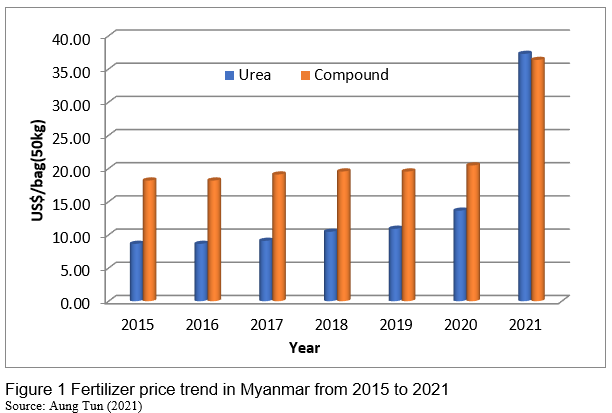
Objectives of the study
The study generally aims to know how the farmers are responding to the rising prices of fertilizers, pesticides and herbicides in all the different townships of Nay Pyi Taw area.
- To study socio-economic conditions of the sample farmers in the study area;
- To explore how the farmers are responding to the chemical agricultural inputs becoming more and more expensive;
- To observe the natural and bio-sustainable alternatives the farmers are employing; and
- To present the findings and information to the national policy makers.
METHODOLOGY
Study sites for data collection
The study took place in Nay Pyi Taw which consists of eight townships, Zeyar Thiri, Pohbba Thiri, Uttara Thiri, Zabu Thiri, Dekina Thiri, Pyinmana, Lewe and Tatkon Townships. In those townships, villages where most farmers and farm workers take residence were the main focus of the research team.
Data collection and analysis
Data collection started in May, 2022 and ended in July, 2022, using the structured questionnaire which was developed by the research team of Department of Agricultural Economics, Yezin Agricultural University (2022) for the survey. The local agricultural officers of the Department of Agricultural Research and Department of Agriculture were given responsibility as enumerators in order to carry out the data collection process. The research team of the Department of Agricultural Economics of the Yezin Agricultural University (YAU) provided the enumerators with the trainings and instructions for data collection.
The sample respondents from mainly rural areas of these townships were selected using simple random sampling. A total of 759 respondents in this study intended to involve them from the whole Nay Pyi Taw area. They are expected to be from diverse backgrounds, and possess different sizes of farms, grow different types of crops or vegetables, and have different levels of education and different sizes of families. The potential respondents were based on the fact that they are the main household members managing farming operations in the farms to collect data on fertilizer, pesticide and herbicide utilization. The respondents were voluntary in a way they can choose to be a part of the research or not. The enumerators visited the households, provided them with the purpose of the study, and requested their voluntary participation. The respondents, who agreed to cooperate with the researchers, were brought into the interview process which was conducted using a structured questionnaire.
RESULTS AND DISCUSSION
Sociodemographic characteristics of respondents of selected households
The average age of the respondents among the 759 sample farmers was 53 years with a standard deviation of 11.82. The number of family members went from 1 to 11 and the respondent households had an average of 5 family members (Table 1).

Based on the respondents’ education levels, they were separated into 5 different categories. These include primary school level where schooling usually takes 5 years, middle school level where schooling usually takes up to 9 years, high school level where schooling usually takes up to 11 years and graduate level where the respondents have received education from the university. Illiterate education level means that reading and writing are two of the things they do not have the ability to do. A very minimal number of respondents, only 0.26% were illiterate. The primary school level respondents represented 40.97% of the total respondent count while graduate respondents made up 4.61%. Among the respondents, 16.21% of them had high school level education while 37.94% had middle school level education (Figure 2).
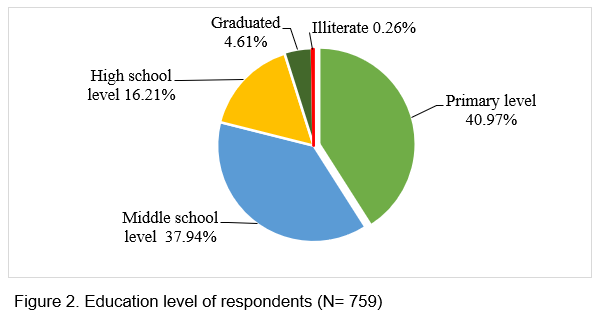
Among the respondents, the male respondents who took charge in the farm operations were found to be 71.01%. Only 11.73% of the respondents were women who were responsible for managing the farming operations (Figure 3). This revealed that over 70% of the people responsible for growing crops and purchasing products for the farms were males in Nay Pyi Taw. The average number of total family members who are active in the farming operations was around 2 (1.88). The family members who worked in the farm operation ranged from 8 to 0 (Table 2).
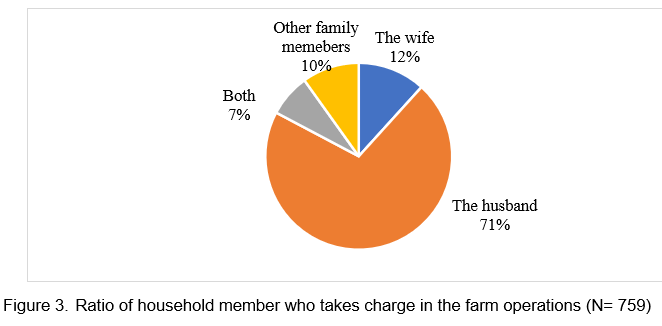

Among the 759 farmer respondents who were active in farming, the average paddy farm size was 1.67 ha and ranged from 0.08 ha to 16.19 ha. Average size of the upland was 0.37 ha. The farm size of land was ranged from 0.01 ha as the smallest to 6.07 ha as the biggest one. For home step garden, average was pointed out to be 0.01 ha and minimum to maximum ranged from 0.01 ha to 0.81 ha. The average size for horticultural crop farm was 0.01 ha, ranging from 0.01 ha as the minimum to 1.62 ha as the maximum (Table 3).

Crops grown by the farmer respondents
Crops grown by the farmer respondents were also investigated by the research team during the research process. There are double and triple cropping patterns since respondents grew more than one type of crops in their paddy farms. The most popular crop for Crop no. 1 was monsoon paddy as it was grown by 90.12% (684 respondents). Myanmar is a country with a noticeable consumption of rice. Myanmar ranked 8th position among 154 countries followed for interest rate on rice consumption per capita and also rice consumption per capita facilitated from 102 kg in 1986 to 155 kg in 2016 (Theingi Myint et al. 2016). For that reason, rice is expected to be the most popular crop.
The study illustrated the pieces of information regarding Crop No.2 in the paddy farms. Summer paddy, again, was found to be the most popular for the Crop No.2 with 37.94% (288 respondents). Black gram ranked as the second most popular with 11.33% (86 respondents). Followed by eggplant and sesame which bother was 1.58% (12 respondents). Illustrated pieces of information regarding Crop No.3, rice was grown by 11 respondents (1.45%) which made it the most popular crop for Crop No.3. There was a significant portion of respondents which was 94.6% (718), who did not grow a third crop in their farms (Table 4).

Farmers who reduced the amounts of chemical fertilizers because of higher price
This part of the research intended to reveal the percentages of respondents who were using fewer amounts of chemical fertilizers because of higher prices in 2022. The percentage of respondents used less amount of chemical fertilizers and how less those amounts would be included in this part. As depicted in Figure 4, 383 (50.46%) of the respondents reduced 0% of the fertilizers they use indicating that they continued to use the exact same amount even though the prices were increasing. Only 10 (1.32%) of the respondents terminated their chemical fertilizer usage completely. Between the residents who continued using the same or bigger amount and stopped their usage fully, 66 (8.70%) decreased the amount they use by 25%, 64 (8.43%) decreased the amount they use by 35%, 198 (26.09%) decreased the amount they use by 50% and 38 (5.01%) decreased the amount they use by 75%. Half of the respondents did not cut back on their chemical fertilizer usage even though it was getting more and more costly. This indicates that it was not inaccurate to assume that the reliance on chemical fertilizers of farmers in the study areas was nowhere near small. The reliance on chemical fertilizers could lead to damaging outcomes such as altered soil fertility, eutrophication and blue baby syndrome from consuming the water polluted by chemical fertilizers.

Farmers who reduced the amounts of chemical pesticides because of higher price
Farmers who reduced the amounts of pesticides because of higher price were illustrated in Figure 5. As seen in the Figure, 509 (67.06%) of the respondents reduced 0% of the pesticides they used indicating that they continued to use the exact same amount even though it was becoming increasingly expensive. Only 10 (1.32%) of the respondents put an end to their pesticide usage completely. Between the residents who continued using the same or bigger amounts and those who stopped their usage fully, 42 (5.53%) decreased the amount they use by 25%, 44 (5.80%) decreased the amount they use by 35%, 114 (15.02%) decreased the amount they use by 50% and 32 (4.22%) decreased the amount they use by 75%. Considerably over half of the respondents who did not reduce their pesticide usage even though it was getting more and more costly revealed that the reliance on pesticides of farmers in Nay Pyi Taw was not minute. The reliance on pesticides was even more significant than that of chemical fertilizers since only 242 respondents (31.88%) made their pesticide consumption smaller while 376 (49.54%) used less amounts of chemical fertilizers (Figure 4). Regarding the pesticide use in the farm, making bodies of water hazardous with a process known as leeching and leading to very urgent health conditions as serious as cancer are some of the negative impacts of pesticides (Jakuboski, 2011).

Farmers who reduced the amounts of herbicides because of higher price
As seen in Figure 6, 523 (68.91%) of the respondents reduced 0% of the chemical herbicides they used indicating that they continued to use the exact same amount even though it was becoming pricier and pricier. Only 25 (3.29%) of the respondents put an end to their herbicide usage completely. Between the residents who continued using the same or bigger amount and stopped their usage fully, 40 (5.27%) decreased the amount they use by 25%, 36 (4.74%) decreased the amount they use by 35%, 110 (14.49%) decreased the amount they use by 50% and 26 (3.43%) decreased the amount they use by 75% (Figure 5). Considerably over half of the respondents who reduced their pesticide usage even though it was getting more and more costly revealed that the reliance on herbicides of farmers in Nay Pyi Taw was nowhere near insignificant. The reliance on herbicides was not noticeably different from that of fertilizers since 242 respondents (31.88%) used less amounts of pesticides while 237 (31.23%) of them used less amounts of herbicides. Toxicity of chemical herbicides towards humans can be seen at high and lower doses, causing cancer and neurodegenerative, reproductive and developmental issues (Aparecida Marin-Morales, Ventura- Camargo and Miyuki Hoshina, 2013).
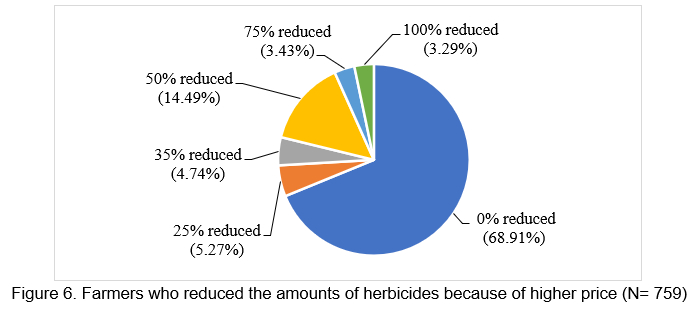
Farmer decision making for using chemical fertilizers, pesticides and herbicides and their reasons
Being the poorest country in South East Asia, the prices rising had salient influences on how Myanmar farmers make their decision on buying the things they need for their farms, forcing them to purchase less amount of chemical fertilizers, pesticides and herbicides (Misachi, 2021). A little bit over half, 383 (50.46%) of the respondents made the decision to apply less and 376 (49.54%) decided not to decrease the amount they use and purchase, as seen in Figure 7.
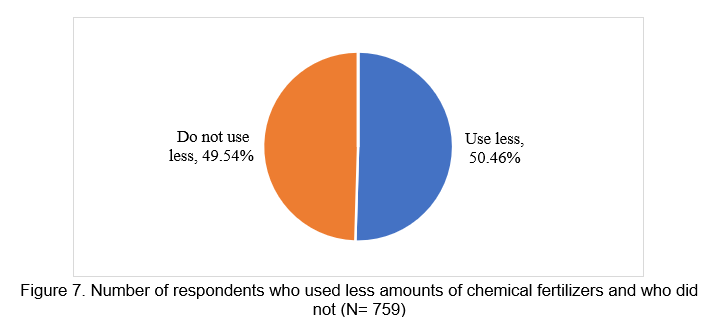
When questioned about the reason why respondents still have not decreased the amounts of fertilizers they use, 357 (49.54%) of the respondents who did not decrease the amounts they use did not provide the research team with answers. There were only 19 respondents out of 376 respondents who did not decrease the amounts of chemical fertilizers they use provided the research team with answers. However, 15 (79%) had no intentions of using less because they were afraid that using less chemical fertilizers might damage the yield (Figure 8). For two of them (11%), using the amounts of chemical fertilizers they used became a norm for them. One (5%) of them had a too small farm and would not make any noticeable difference in expenditures if they decreased the amounts of chemical fertilizers they use. Another one (5%) did not use less because they could afford the increasingly expensive chemical fertilizers. According to this set of data, damaging the yield was a risk that farmers did not want to take and spending more was something they were willing to do. Using chemical fertilizers also was known as one of the most commonly processes required in operating a farm (Figure 7).
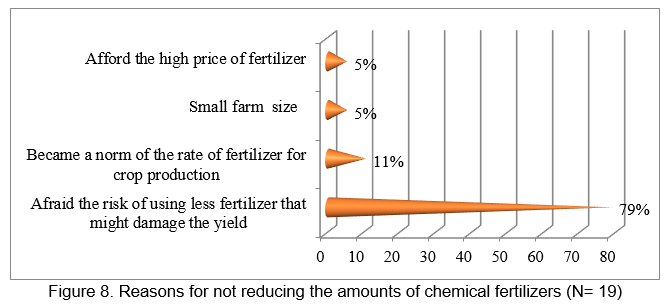
In Figure 9, it was revealed that 250 (32.94%) of the respondents made the decision to apply less, 3 (0.40%) had not used pesticides since they started their farming operations and well over half, 506 (66.67%) decided not to decrease the amount they purchase and use.
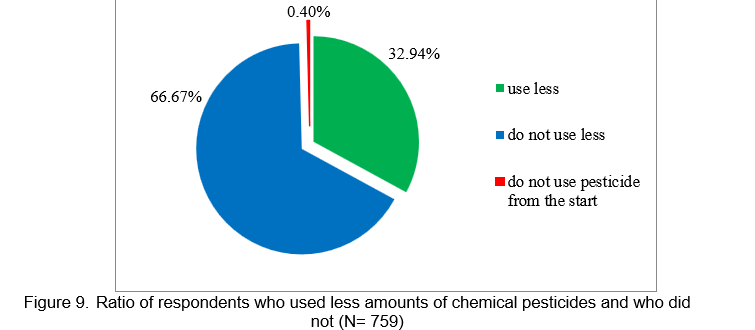
When asked about the reason why respondents still had not decreased the amounts of chemical pesticides they use, there were only 17 respondents out of 506 respondents who did not decrease the amounts of chemical pesticides they use provided the research team with answers. However, 13 (76%) had no intentions of using less because they were afraid that pest related damages would become bigger if they used less (Figure 10). Among them, one (6%) sample used fluctuating amounts of chemical pesticides that depended on the severity of the pests on the farm. One (6%) of them had seen the number of pests on their farm that motivated them not to decrease the amounts of chemical pesticides that had being used. Another one (6%) did not use less out of a habit of using less if it did not belong to him. The last one (6%) said the budget was big enough and they could afford to buy the chemical pesticides (Figure 9). This set of data revealed that respondents value the protection from pests more than money.
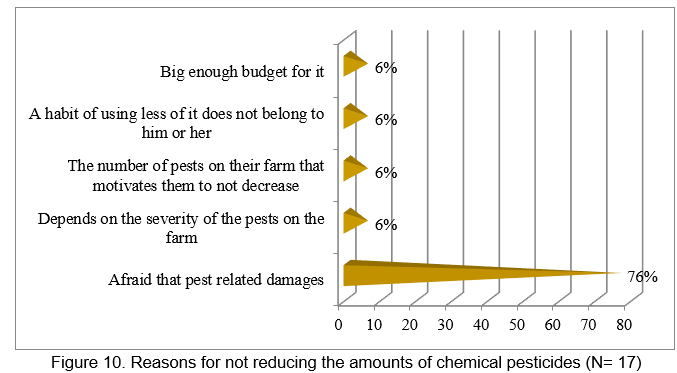
Among the respondents, 238 (31.36%) used less amounts of chemical herbicides while 517 (68.2%) revealed that they were well over half doing the opposite and 4 (0.53%) did not use the chemical herbicides from the start of their farming activities as shown in Figure 11.

There were only 17 out of 517 respondents who did not decrease the amounts of chemical herbicides they used provided the research team with answers. When asked about the reason why respondents still had not decrease the amounts of herbicides they use, 500 (96.71%) of the respondents who did not decrease the amounts they used refused to answer the questions asked by the research team. However, 13 (76%) had no intentions of using less because they were worried that weeds related damages would become bigger if they used less. For one of them (6%), using the amount of herbicide depended on the weeds on the farm. Another one (6%) of them did not use less or more. Another respondent (6%) did not have the habit of using less. The last one (6%) was because he or she had big enough budget for it (Figure 12).

The solution of the natural and bio-sustainable alternatives the farmers are employing
For farmers, not to decrease the size of the yield was something they consider extremely crucial. Although hundreds of farmer respondents used less amounts of chemical fertilizers, pesticides and herbicides, they had no desire to sacrifice their yield. So, a solution was born. That solution was fertilizer, pesticide and herbicide alternatives which most of them are natural, environmentally friendly and cost less. Applying that solution was the ability to lead the outcomes that were not just for saving money. Those outcomes could be healthier soil, lower pollution level in the environment and less damage towards people who were around the farm or synthetic fertilizers, pesticides and herbicides.
As illustrated in Figure 13, animal manure took the position of the most applied alternative for reducing chemical fertilizers for being used by 300 (78.33%) of the 383 respondents who used less amounts of chemical fertilizers. Composts ranked as the second most used fertilizer alternative.
For the second alternative, since respondents used more than one alternative, compost ranked the most popular secondary alternative, used by 38 (9.91%) respondents. Gypsum was used the second most by 5 (1.31%) of the respondents. However, 336 (87.73%) which was almost all the respondents did not have a secondary alternative.
Some of the benefits of animal manure include support for plant growth and development for having high proportions of Nitrogen (N) and Potassium (K), medium proportions of Calcium (Ca) and Phosphorus (P), and low proportion of Magnesium (Mg) and Sulphur (S), organic matter being added to the soil, the composition of organic solids being between 20% and 40%, given the high nitrogen content, decomposition of organic matter being developed more quickly, despite having low content of phosphorus (P), manure prevents blockage of this element, making it available for plants (Plaster 2000; Luévano et al., 2001).
In addition, some of the benefits of compost include preventing soil erosion, promoting healthier plant growth, reducing wastes, improving soil health, etc. (BENEFITS OF COMPOST, 2020). These factors pointed out their decision making for using alternative fertilizers for crop production is on the right tract.

Alternative pesticides that are used by respondents were explored in Figure 14. The most used pesticide alternative No.1 position was taken by natural pesticide which was used by 64 (25.60%) of the respondents who applied less amounts of chemical pesticides. Among them, 25 (10.00%) respondents used minimum amount of pesticide only when necessary. Three (1.20%) respondents sprayed soap water for protection against the pests. Only one respondent (0.40%) used yellow sticker as the pest protection method. According to the study of McCoy, 2020, some of the benefits of natural pesticides include easily breaking down in the environment, not leaving residues and being able to select specific targets and not harm other animals such as bees, therefore farmers who use natural pesticides might get these benefits for sustainable crop production.
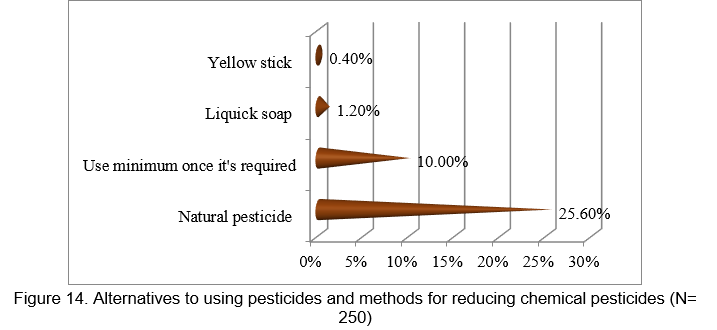
Herbicide usage could also be replaced by natural alternatives. More than one alternative could be used. For that, there were top five alternatives listed on Figure 15. For 122 (51.26%) of the respondents who used less herbicide, removing the weeds by hand was the most preferred alternative. Removing weeds by deep ploughing was preferred by 16 (6.72%) of the respondents. Both of the alternatives produced no chemical pollution whatsoever since both of those most popular alternatives were done by physical manual labor. But a significant number of respondents which was 88 (36.97%), their answers were not seen in the data set.
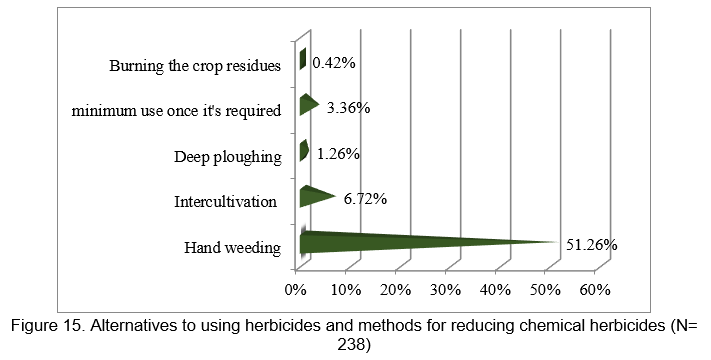
CONCLUSION AND POLICY RECOMMANDATION
The choice for natural, organic and environmentally friendly fertilizer, pesticide and herbicide alternatives had increased in Nay Pyi Taw since the prices of chemical agricultural inputs started to increase. Chemical fertilizers were something more replaceable than pesticides and herbicides since 50.46% of the respondents used less fertilizers and a bit over 30% used less pesticides and herbicides. The reasons for that probably are easy access to manure, the effectiveness and almost free. When using alternatives, most respondents did not use two of them at the same time. None of them used three of them at the same time. Nowadays agriculture should be more and more natural, organic and environmentally-friendly in a sustainable progress. However, the study pointed out it is safe to assume that it might not be on a long-term basis.
The reason is that price seems to be the main obstacle hindering farmers to buy and use synthetic fertilizers, pesticides and herbicides. Once they become more and more affordable, the percentage of farmers who uses organic alternatives dropping down is a change that might be commonly seen. Respondents were willing to sacrifice their financial well-being in order to operate a farm that gives them the size of yield they want.
Even though farmers are purchasing and applying costly agricultural supplements to receive a sizable yield, the profitability of a farm can be smaller or even a situation where losses can be found if the buyers are not willing to pay them the desirable price for their products when they sell them. At the moment when they are facing this kind of problems, they will gain the ability to make profits only if they reduce the amount of money spent in the production process. Because of that, to minimize the production cost, cheap alternatives with plenty of benefits will be needed to be utilized instead of the expensive ones that are being in use of the agricultural industry these days. As it was found during the research process, a handful of farmers were changing and employing their methods by using animal manure instead of high-priced chemical fertilizers, natural pesticides and eliminating weeds by hand. That kind of changes is not only extremely affordable but could also be sustainable. For those reasons, the research team would like to suggest the policy makers of agricultural sector to make an intervention by spreading awareness and organize extension programs in order to influence farmers to take advantage of cheaper alternatives that have very low potential to cause damage to the natural environment during the times when agricultural inputs are considerably expensive. Changes and new additions can be added to the national policies using the pieces of information included in this report and now is the critical time for encouraging farmers to choose the way towards sustainable agriculture in Myanmar.
REFERENCES
Aparecida Marin-Morales, M., Campos Ventura- Camargo, B. and Miyuki Hoshina, M., 2013. Toxicity of Herbicides: Impact on Aquatic and Soil Biota and Human Health. [online] intechopen. Available at: <https://www.intechopen.com/chapters/44984> [Accessed 29 September 2022].
Aung Tun , 2021, Agriculture in a State of Woe Following Myanmar’s 2021 Military Coup, ISEAS YUSOF
ISHAK INSTITUTE, ISSUE: 2022 No.20, ISSN 2335-6677, https://www.iseas.edu.sg/wp-content/uploads/2022/01/ISEAS_Perspective_2022_20.pdf
DOP, 2021 Agricultural at a glance. Department of Planning, Ministry of Agriculture, Livestock and Irrigation, Myanmar.
Jakuboski, S., 2011. The Dangers of Pesticides. [online] Scitable. Available at: <https://www.nature. com/scitable/blog/green-science/the_dangers_of_pesticides/> [Accessed 29 September 2022].
Luévano A y Velázquez N E 2001 Ejemplo singular en los agronegocios. Estiércol vacuno: de problema ambiental a excelente recurso. Revista Mexicana de Agronegocios. Año 5 Vol. 9: 306-320. Available online at http://redalyc.uaemex.mx/pdf/141/14100905.pdf/> [Accessed 21 September 2022]
McCoy, T., 2020. rganic vs. Conventional (Synthetic) Pesticides: Advantages and Disadvantages. [online] Virginia Cooperative Extension. Available at: <https://www.pubs.ext.vt.edu/content/dam/ pubs_ext_vt_edu/ENTO/ento-384/ENTO-384.pdf> [Accessed 28 September 2022].
Misachi, J., 2021. Southeast Asia. [online] worldatlas. Available at: <https://www.worldatlas.com/geography/ southeast-asia.html> [Accessed 29 September 2022].
Plaster E 2000 La ciencia del suelo y su manejo. Madrid: Thompson Editores. p. 248/> [Accessed 23 September 2022].
The Global New Light of Myanmar. 2022. Fertilizer prices on the rise. [online] Available at: <https://www.gnlm.com.mm/fertilizer-prices-on-the-rise/> [Accessed 21 September 2022].
Theingi Myint, Nang Ei Mon The, Ei Mon Thidar Kyaw, Yee Mon Aung and Myint Myat Moe (2016). Study on Per Capita Rice Consumption and Ratio of Household Expenditure in Myanmar (final report). Department of Agricultural Economics, Naypyidaw, Myanmar: Yezin Agricultural University.
US composing council. 2020. BENEFITS OF COMPOST. [online] Available at: <https://www.composting council.org/page/CompostBenefits> [Accessed 28 September 2022].
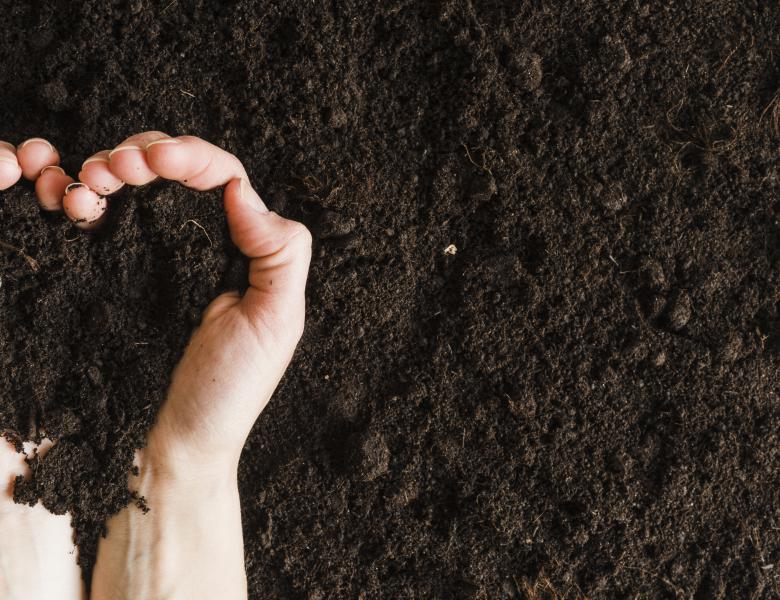


Is It a Crossroad towards Myanmar’s Sustainable Agriculture Sector?
ABSTRACT
This is a research that will let the reader have a glimpse into how farmers in the Nay Pyi Taw area are facing the challenge of increasing fertilizer, pesticide and herbicide prices in recent years. A total of 759 respondents from 8 townships in Nay Pyi Taw were interviewed about their socioeconomic characteristics and their fertilizer, pesticide and herbicide usage in May, 2022. The price increases have the ability to force the farmers into utilizing natural and bio-sustainable alternatives such as animal manure, yellow stick, manual weeding and etc. instead of using more or the same amounts of fertilizers, pesticides and herbicides. About 50% of the respondents decreased the amounts of fertilizers they used, 32.94% for pesticides and 31.36% for herbicides. The reliance on pesticides and herbicides was shown to be bigger than that of fertilizers since smaller people were choosing to use fewer amounts of pesticides and herbicides. Respondents valued the safety of their farms from pests and weeds more than money, unintentionally damaging the environment with their decision. Most respondents decreased the amount they used only because of the price. Most popular fertilizer was manure; most commonly used pesticide was naturally made or organic pesticide; and most preferred herbicide to remove the weeds was using physical labor. However, most respondents used one or two alternatives at the same time. Those changes can become more fruitful with the pragmatic and adequate decisions making from national policy makers. With up-to-date and on-ground information for farmers presented, the policy makers will have the ability to install constructive policies. For those reasons, the research team would like to suggest the policy makers of the agriculture sector to make an intervention by spreading awareness and organize extension programs in order to influence farmers to take advantage of cheaper alternatives that have very low potential to cause damage to the natural environment during the times when agricultural inputs are considerably expensive. Changes and new additions can be added to the national policies using the pieces of information included in this report and now is the critical time for encouraging farmers to choose the way towards sustainable agriculture in Myanmar.
Keywords: Farmers, fertilizer, pesticide, herbicide, price, bio-sustainable, natural, policy, policy makers
INTRODUCTION
The agricultural industry in Myanmar plays a very significant role in the national economy since it possesses the largest employment force in the country and is responsible for 37.8% of the GDP (DOP, 2021). Being aware of the situation, fluctuations in the price of industry related commodities such as fertilizers, pesticides and herbicides can have noticeable influence on active participants in the industry. In the domestic market, before April 13, 2022, a bag of fertilizer has a price around US$45.45 (100,000 kyats) and increased to US$68.18 (150,000 kyats) in August and mid-September and it became nearly US$86.36 (190,000 kyats) because of exchange rate and the rise in transportation related costs (Fertilizer prices on the rise, 2022). The impacts of recent global and domestic price increases of commodities on the farmers of the country are nothing less compared to its nationwide price increase. The price increases year by year especially after 2020 can force farmers to cut back on using chemical products in their farms and utilize natural bio-alternative fertilizers, pesticides and herbicides (Figure 1). Having said that, it has become very salient for the policy makers to make positively impactful decisions concerning farming with sustainability and success, in order to do that, it is necessary to possess as much on-ground information about farmers’ conditions, problems and solutions as possible.
Objectives of the study
The study generally aims to know how the farmers are responding to the rising prices of fertilizers, pesticides and herbicides in all the different townships of Nay Pyi Taw area.
METHODOLOGY
Study sites for data collection
The study took place in Nay Pyi Taw which consists of eight townships, Zeyar Thiri, Pohbba Thiri, Uttara Thiri, Zabu Thiri, Dekina Thiri, Pyinmana, Lewe and Tatkon Townships. In those townships, villages where most farmers and farm workers take residence were the main focus of the research team.
Data collection and analysis
Data collection started in May, 2022 and ended in July, 2022, using the structured questionnaire which was developed by the research team of Department of Agricultural Economics, Yezin Agricultural University (2022) for the survey. The local agricultural officers of the Department of Agricultural Research and Department of Agriculture were given responsibility as enumerators in order to carry out the data collection process. The research team of the Department of Agricultural Economics of the Yezin Agricultural University (YAU) provided the enumerators with the trainings and instructions for data collection.
The sample respondents from mainly rural areas of these townships were selected using simple random sampling. A total of 759 respondents in this study intended to involve them from the whole Nay Pyi Taw area. They are expected to be from diverse backgrounds, and possess different sizes of farms, grow different types of crops or vegetables, and have different levels of education and different sizes of families. The potential respondents were based on the fact that they are the main household members managing farming operations in the farms to collect data on fertilizer, pesticide and herbicide utilization. The respondents were voluntary in a way they can choose to be a part of the research or not. The enumerators visited the households, provided them with the purpose of the study, and requested their voluntary participation. The respondents, who agreed to cooperate with the researchers, were brought into the interview process which was conducted using a structured questionnaire.
RESULTS AND DISCUSSION
Sociodemographic characteristics of respondents of selected households
The average age of the respondents among the 759 sample farmers was 53 years with a standard deviation of 11.82. The number of family members went from 1 to 11 and the respondent households had an average of 5 family members (Table 1).
Based on the respondents’ education levels, they were separated into 5 different categories. These include primary school level where schooling usually takes 5 years, middle school level where schooling usually takes up to 9 years, high school level where schooling usually takes up to 11 years and graduate level where the respondents have received education from the university. Illiterate education level means that reading and writing are two of the things they do not have the ability to do. A very minimal number of respondents, only 0.26% were illiterate. The primary school level respondents represented 40.97% of the total respondent count while graduate respondents made up 4.61%. Among the respondents, 16.21% of them had high school level education while 37.94% had middle school level education (Figure 2).
Among the respondents, the male respondents who took charge in the farm operations were found to be 71.01%. Only 11.73% of the respondents were women who were responsible for managing the farming operations (Figure 3). This revealed that over 70% of the people responsible for growing crops and purchasing products for the farms were males in Nay Pyi Taw. The average number of total family members who are active in the farming operations was around 2 (1.88). The family members who worked in the farm operation ranged from 8 to 0 (Table 2).
Among the 759 farmer respondents who were active in farming, the average paddy farm size was 1.67 ha and ranged from 0.08 ha to 16.19 ha. Average size of the upland was 0.37 ha. The farm size of land was ranged from 0.01 ha as the smallest to 6.07 ha as the biggest one. For home step garden, average was pointed out to be 0.01 ha and minimum to maximum ranged from 0.01 ha to 0.81 ha. The average size for horticultural crop farm was 0.01 ha, ranging from 0.01 ha as the minimum to 1.62 ha as the maximum (Table 3).
Crops grown by the farmer respondents
Crops grown by the farmer respondents were also investigated by the research team during the research process. There are double and triple cropping patterns since respondents grew more than one type of crops in their paddy farms. The most popular crop for Crop no. 1 was monsoon paddy as it was grown by 90.12% (684 respondents). Myanmar is a country with a noticeable consumption of rice. Myanmar ranked 8th position among 154 countries followed for interest rate on rice consumption per capita and also rice consumption per capita facilitated from 102 kg in 1986 to 155 kg in 2016 (Theingi Myint et al. 2016). For that reason, rice is expected to be the most popular crop.
The study illustrated the pieces of information regarding Crop No.2 in the paddy farms. Summer paddy, again, was found to be the most popular for the Crop No.2 with 37.94% (288 respondents). Black gram ranked as the second most popular with 11.33% (86 respondents). Followed by eggplant and sesame which bother was 1.58% (12 respondents). Illustrated pieces of information regarding Crop No.3, rice was grown by 11 respondents (1.45%) which made it the most popular crop for Crop No.3. There was a significant portion of respondents which was 94.6% (718), who did not grow a third crop in their farms (Table 4).
Farmers who reduced the amounts of chemical fertilizers because of higher price
This part of the research intended to reveal the percentages of respondents who were using fewer amounts of chemical fertilizers because of higher prices in 2022. The percentage of respondents used less amount of chemical fertilizers and how less those amounts would be included in this part. As depicted in Figure 4, 383 (50.46%) of the respondents reduced 0% of the fertilizers they use indicating that they continued to use the exact same amount even though the prices were increasing. Only 10 (1.32%) of the respondents terminated their chemical fertilizer usage completely. Between the residents who continued using the same or bigger amount and stopped their usage fully, 66 (8.70%) decreased the amount they use by 25%, 64 (8.43%) decreased the amount they use by 35%, 198 (26.09%) decreased the amount they use by 50% and 38 (5.01%) decreased the amount they use by 75%. Half of the respondents did not cut back on their chemical fertilizer usage even though it was getting more and more costly. This indicates that it was not inaccurate to assume that the reliance on chemical fertilizers of farmers in the study areas was nowhere near small. The reliance on chemical fertilizers could lead to damaging outcomes such as altered soil fertility, eutrophication and blue baby syndrome from consuming the water polluted by chemical fertilizers.
Farmers who reduced the amounts of chemical pesticides because of higher price
Farmers who reduced the amounts of pesticides because of higher price were illustrated in Figure 5. As seen in the Figure, 509 (67.06%) of the respondents reduced 0% of the pesticides they used indicating that they continued to use the exact same amount even though it was becoming increasingly expensive. Only 10 (1.32%) of the respondents put an end to their pesticide usage completely. Between the residents who continued using the same or bigger amounts and those who stopped their usage fully, 42 (5.53%) decreased the amount they use by 25%, 44 (5.80%) decreased the amount they use by 35%, 114 (15.02%) decreased the amount they use by 50% and 32 (4.22%) decreased the amount they use by 75%. Considerably over half of the respondents who did not reduce their pesticide usage even though it was getting more and more costly revealed that the reliance on pesticides of farmers in Nay Pyi Taw was not minute. The reliance on pesticides was even more significant than that of chemical fertilizers since only 242 respondents (31.88%) made their pesticide consumption smaller while 376 (49.54%) used less amounts of chemical fertilizers (Figure 4). Regarding the pesticide use in the farm, making bodies of water hazardous with a process known as leeching and leading to very urgent health conditions as serious as cancer are some of the negative impacts of pesticides (Jakuboski, 2011).
Farmers who reduced the amounts of herbicides because of higher price
As seen in Figure 6, 523 (68.91%) of the respondents reduced 0% of the chemical herbicides they used indicating that they continued to use the exact same amount even though it was becoming pricier and pricier. Only 25 (3.29%) of the respondents put an end to their herbicide usage completely. Between the residents who continued using the same or bigger amount and stopped their usage fully, 40 (5.27%) decreased the amount they use by 25%, 36 (4.74%) decreased the amount they use by 35%, 110 (14.49%) decreased the amount they use by 50% and 26 (3.43%) decreased the amount they use by 75% (Figure 5). Considerably over half of the respondents who reduced their pesticide usage even though it was getting more and more costly revealed that the reliance on herbicides of farmers in Nay Pyi Taw was nowhere near insignificant. The reliance on herbicides was not noticeably different from that of fertilizers since 242 respondents (31.88%) used less amounts of pesticides while 237 (31.23%) of them used less amounts of herbicides. Toxicity of chemical herbicides towards humans can be seen at high and lower doses, causing cancer and neurodegenerative, reproductive and developmental issues (Aparecida Marin-Morales, Ventura- Camargo and Miyuki Hoshina, 2013).
Farmer decision making for using chemical fertilizers, pesticides and herbicides and their reasons
Being the poorest country in South East Asia, the prices rising had salient influences on how Myanmar farmers make their decision on buying the things they need for their farms, forcing them to purchase less amount of chemical fertilizers, pesticides and herbicides (Misachi, 2021). A little bit over half, 383 (50.46%) of the respondents made the decision to apply less and 376 (49.54%) decided not to decrease the amount they use and purchase, as seen in Figure 7.
When questioned about the reason why respondents still have not decreased the amounts of fertilizers they use, 357 (49.54%) of the respondents who did not decrease the amounts they use did not provide the research team with answers. There were only 19 respondents out of 376 respondents who did not decrease the amounts of chemical fertilizers they use provided the research team with answers. However, 15 (79%) had no intentions of using less because they were afraid that using less chemical fertilizers might damage the yield (Figure 8). For two of them (11%), using the amounts of chemical fertilizers they used became a norm for them. One (5%) of them had a too small farm and would not make any noticeable difference in expenditures if they decreased the amounts of chemical fertilizers they use. Another one (5%) did not use less because they could afford the increasingly expensive chemical fertilizers. According to this set of data, damaging the yield was a risk that farmers did not want to take and spending more was something they were willing to do. Using chemical fertilizers also was known as one of the most commonly processes required in operating a farm (Figure 7).
In Figure 9, it was revealed that 250 (32.94%) of the respondents made the decision to apply less, 3 (0.40%) had not used pesticides since they started their farming operations and well over half, 506 (66.67%) decided not to decrease the amount they purchase and use.
When asked about the reason why respondents still had not decreased the amounts of chemical pesticides they use, there were only 17 respondents out of 506 respondents who did not decrease the amounts of chemical pesticides they use provided the research team with answers. However, 13 (76%) had no intentions of using less because they were afraid that pest related damages would become bigger if they used less (Figure 10). Among them, one (6%) sample used fluctuating amounts of chemical pesticides that depended on the severity of the pests on the farm. One (6%) of them had seen the number of pests on their farm that motivated them not to decrease the amounts of chemical pesticides that had being used. Another one (6%) did not use less out of a habit of using less if it did not belong to him. The last one (6%) said the budget was big enough and they could afford to buy the chemical pesticides (Figure 9). This set of data revealed that respondents value the protection from pests more than money.
Among the respondents, 238 (31.36%) used less amounts of chemical herbicides while 517 (68.2%) revealed that they were well over half doing the opposite and 4 (0.53%) did not use the chemical herbicides from the start of their farming activities as shown in Figure 11.
There were only 17 out of 517 respondents who did not decrease the amounts of chemical herbicides they used provided the research team with answers. When asked about the reason why respondents still had not decrease the amounts of herbicides they use, 500 (96.71%) of the respondents who did not decrease the amounts they used refused to answer the questions asked by the research team. However, 13 (76%) had no intentions of using less because they were worried that weeds related damages would become bigger if they used less. For one of them (6%), using the amount of herbicide depended on the weeds on the farm. Another one (6%) of them did not use less or more. Another respondent (6%) did not have the habit of using less. The last one (6%) was because he or she had big enough budget for it (Figure 12).
The solution of the natural and bio-sustainable alternatives the farmers are employing
For farmers, not to decrease the size of the yield was something they consider extremely crucial. Although hundreds of farmer respondents used less amounts of chemical fertilizers, pesticides and herbicides, they had no desire to sacrifice their yield. So, a solution was born. That solution was fertilizer, pesticide and herbicide alternatives which most of them are natural, environmentally friendly and cost less. Applying that solution was the ability to lead the outcomes that were not just for saving money. Those outcomes could be healthier soil, lower pollution level in the environment and less damage towards people who were around the farm or synthetic fertilizers, pesticides and herbicides.
As illustrated in Figure 13, animal manure took the position of the most applied alternative for reducing chemical fertilizers for being used by 300 (78.33%) of the 383 respondents who used less amounts of chemical fertilizers. Composts ranked as the second most used fertilizer alternative.
For the second alternative, since respondents used more than one alternative, compost ranked the most popular secondary alternative, used by 38 (9.91%) respondents. Gypsum was used the second most by 5 (1.31%) of the respondents. However, 336 (87.73%) which was almost all the respondents did not have a secondary alternative.
Some of the benefits of animal manure include support for plant growth and development for having high proportions of Nitrogen (N) and Potassium (K), medium proportions of Calcium (Ca) and Phosphorus (P), and low proportion of Magnesium (Mg) and Sulphur (S), organic matter being added to the soil, the composition of organic solids being between 20% and 40%, given the high nitrogen content, decomposition of organic matter being developed more quickly, despite having low content of phosphorus (P), manure prevents blockage of this element, making it available for plants (Plaster 2000; Luévano et al., 2001).
In addition, some of the benefits of compost include preventing soil erosion, promoting healthier plant growth, reducing wastes, improving soil health, etc. (BENEFITS OF COMPOST, 2020). These factors pointed out their decision making for using alternative fertilizers for crop production is on the right tract.
Alternative pesticides that are used by respondents were explored in Figure 14. The most used pesticide alternative No.1 position was taken by natural pesticide which was used by 64 (25.60%) of the respondents who applied less amounts of chemical pesticides. Among them, 25 (10.00%) respondents used minimum amount of pesticide only when necessary. Three (1.20%) respondents sprayed soap water for protection against the pests. Only one respondent (0.40%) used yellow sticker as the pest protection method. According to the study of McCoy, 2020, some of the benefits of natural pesticides include easily breaking down in the environment, not leaving residues and being able to select specific targets and not harm other animals such as bees, therefore farmers who use natural pesticides might get these benefits for sustainable crop production.
Herbicide usage could also be replaced by natural alternatives. More than one alternative could be used. For that, there were top five alternatives listed on Figure 15. For 122 (51.26%) of the respondents who used less herbicide, removing the weeds by hand was the most preferred alternative. Removing weeds by deep ploughing was preferred by 16 (6.72%) of the respondents. Both of the alternatives produced no chemical pollution whatsoever since both of those most popular alternatives were done by physical manual labor. But a significant number of respondents which was 88 (36.97%), their answers were not seen in the data set.
CONCLUSION AND POLICY RECOMMANDATION
The choice for natural, organic and environmentally friendly fertilizer, pesticide and herbicide alternatives had increased in Nay Pyi Taw since the prices of chemical agricultural inputs started to increase. Chemical fertilizers were something more replaceable than pesticides and herbicides since 50.46% of the respondents used less fertilizers and a bit over 30% used less pesticides and herbicides. The reasons for that probably are easy access to manure, the effectiveness and almost free. When using alternatives, most respondents did not use two of them at the same time. None of them used three of them at the same time. Nowadays agriculture should be more and more natural, organic and environmentally-friendly in a sustainable progress. However, the study pointed out it is safe to assume that it might not be on a long-term basis.
The reason is that price seems to be the main obstacle hindering farmers to buy and use synthetic fertilizers, pesticides and herbicides. Once they become more and more affordable, the percentage of farmers who uses organic alternatives dropping down is a change that might be commonly seen. Respondents were willing to sacrifice their financial well-being in order to operate a farm that gives them the size of yield they want.
Even though farmers are purchasing and applying costly agricultural supplements to receive a sizable yield, the profitability of a farm can be smaller or even a situation where losses can be found if the buyers are not willing to pay them the desirable price for their products when they sell them. At the moment when they are facing this kind of problems, they will gain the ability to make profits only if they reduce the amount of money spent in the production process. Because of that, to minimize the production cost, cheap alternatives with plenty of benefits will be needed to be utilized instead of the expensive ones that are being in use of the agricultural industry these days. As it was found during the research process, a handful of farmers were changing and employing their methods by using animal manure instead of high-priced chemical fertilizers, natural pesticides and eliminating weeds by hand. That kind of changes is not only extremely affordable but could also be sustainable. For those reasons, the research team would like to suggest the policy makers of agricultural sector to make an intervention by spreading awareness and organize extension programs in order to influence farmers to take advantage of cheaper alternatives that have very low potential to cause damage to the natural environment during the times when agricultural inputs are considerably expensive. Changes and new additions can be added to the national policies using the pieces of information included in this report and now is the critical time for encouraging farmers to choose the way towards sustainable agriculture in Myanmar.
REFERENCES
Aparecida Marin-Morales, M., Campos Ventura- Camargo, B. and Miyuki Hoshina, M., 2013. Toxicity of Herbicides: Impact on Aquatic and Soil Biota and Human Health. [online] intechopen. Available at: <https://www.intechopen.com/chapters/44984> [Accessed 29 September 2022].
Aung Tun , 2021, Agriculture in a State of Woe Following Myanmar’s 2021 Military Coup, ISEAS YUSOF
ISHAK INSTITUTE, ISSUE: 2022 No.20, ISSN 2335-6677, https://www.iseas.edu.sg/wp-content/uploads/2022/01/ISEAS_Perspective_2022_20.pdf
DOP, 2021 Agricultural at a glance. Department of Planning, Ministry of Agriculture, Livestock and Irrigation, Myanmar.
Jakuboski, S., 2011. The Dangers of Pesticides. [online] Scitable. Available at: <https://www.nature. com/scitable/blog/green-science/the_dangers_of_pesticides/> [Accessed 29 September 2022].
Luévano A y Velázquez N E 2001 Ejemplo singular en los agronegocios. Estiércol vacuno: de problema ambiental a excelente recurso. Revista Mexicana de Agronegocios. Año 5 Vol. 9: 306-320. Available online at http://redalyc.uaemex.mx/pdf/141/14100905.pdf/> [Accessed 21 September 2022]
McCoy, T., 2020. rganic vs. Conventional (Synthetic) Pesticides: Advantages and Disadvantages. [online] Virginia Cooperative Extension. Available at: <https://www.pubs.ext.vt.edu/content/dam/ pubs_ext_vt_edu/ENTO/ento-384/ENTO-384.pdf> [Accessed 28 September 2022].
Misachi, J., 2021. Southeast Asia. [online] worldatlas. Available at: <https://www.worldatlas.com/geography/ southeast-asia.html> [Accessed 29 September 2022].
Plaster E 2000 La ciencia del suelo y su manejo. Madrid: Thompson Editores. p. 248/> [Accessed 23 September 2022].
The Global New Light of Myanmar. 2022. Fertilizer prices on the rise. [online] Available at: <https://www.gnlm.com.mm/fertilizer-prices-on-the-rise/> [Accessed 21 September 2022].
Theingi Myint, Nang Ei Mon The, Ei Mon Thidar Kyaw, Yee Mon Aung and Myint Myat Moe (2016). Study on Per Capita Rice Consumption and Ratio of Household Expenditure in Myanmar (final report). Department of Agricultural Economics, Naypyidaw, Myanmar: Yezin Agricultural University.
US composing council. 2020. BENEFITS OF COMPOST. [online] Available at: <https://www.composting council.org/page/CompostBenefits> [Accessed 28 September 2022].